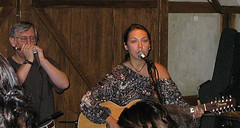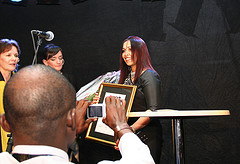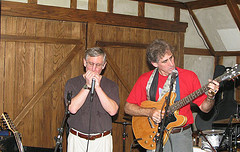A third man has been charged with the murder of journalist Martin O’Hagan, who was shot dead in September 2001.
Tag Archives: journalist
RSF: Burmese journalist U Win Tin has been released after 19 years in prison
Reporters Without Borders and the Burma Media Association are celebrating the release of the Burmese journalist U Win Tin after 19 years in detention.
Investigative vocalists: the musical talents of world-renowned journalists
Our woman on the ground at GIJC Lillehammer (well, she was on duty for Journalisten.no, but we managed to nab a little bit of her spare time) has sent these rather insightful pictures back. It turns out that there might be a correlation between investigative skills and musical talent.
Introducing…on harmonica, David Kaplan, the director of the International Consortium for Investigative Journalists (ICIJ). Playing with him is Mark Hunter on guitar, founding member of the Global Investigative Journalism Network.
And, Ana Simonovska, a Macedonian journalist with an exceptional voice, accompanied by David Kaplan.

Musical talents aside, here’s Sonali Samarasinghe, being caught on a mobile phone camera as she’s awarded the Global Shining Light Award, for her articles covering corruption and abuse of power in Sri Lanka.

It seems that the musical talent wasn’t shared by the British journalists – where was Robert Fisk while these pictures were taken?
All photos courtesy of Kristine Lowe, for Journalisten. The full set can be seen over at Flickr. Kristine Lowe completes her reportage over on her blog.
MediaGuardian: Journalist recruitment freeze at the Independent
In an interview with MediaGuardian, the Independent’s editor, Roger Alton, said that he will not be recruiting any more journalists on the title despite the increase in its cover price to £1.
MediaGuardian: View from the Telegraph newsroom
Roy Greenslade prints an email from a Daily Telegraph journalist, containing their thoughts on the new culture within newspapers.
Online Journalism Scandinavia: Waiting for the CAR to arrive
Earlier in the week we blogged that the Global Investigative Journalism Conference in Lillehammer (GIJC) had received a little criticism for being a bit 1.0 in its coverage. But if its partcipants made limited use of the social web to report live from the event, the Computer Assisted Reporting (CAR) contingent was out in force and here’s what they had to say.
Paul Myers, a BBC specialist in internet research, and web trainer, told Journalism.co.uk how slow CAR is in the UK. “People pick up on the flashy stuff like Google maps, but not CAR,” Myers said.
“This is quite typical in my experience – lots of resistance when I started training journalists in using the internet at BBC in the early 90s. It has been uphill struggle to convince people to use the web,” he told us.
In an opening session, the director of computer-assisted reporting at ProPublica, Jennifer LaFleur, urged people not to be deterred by how complicated it sounds. “Computer assisted reporting (CAR) is doing stories based on data analysis, but it’s really just working with public records,” she said.
“Don’t get intimidated by the statistics, maths or excel and access focus: these are just the tools we use to report with.”
Along with database editor Helena Bengtsson, from Sweden’s public broadcaster SVT, LaFleur highlighted several recent successful news stories that had been unearthed by using CAR.
One, an investigation into the voting patterns of Swedish EU-parliamentarians, showed that several of the most high-profile parlimentarians abstained in 50 per cent or more of cases, causing political outcry.
But, maybe journalists should leave the more high powered CAR to the IT people? No, was the blunt answer to that audience question. CAR should be par for the course, said LaFleur. “90 per cent of stories we presented here were done with Access and Excel. I am a journalist doing journalism,” she said.
“You have to interview the data as you interview a person,’ added Helena Bengtsson. “When I do a query on data… I’m asking the data as a journalist.
“There is a lot of information in the data that IT-people wouldn’t have discovered. We’re journos first, data-specialists second,” Bengtsson said.
GCIJ Lillehammer also ran classes on RSS, scraping the web, being an online ‘bloodhound’ and effective web searching.
“There are two reasons for that: we have the training expertise and see major need for training in web research and computer assisted reporting”, Haakon Hagsbö, from SKUP (a Norwegian foundation for investigative journalism) and one of the organisers of GIJC Lillehammer, told Journalism.co.uk.
“It has certainly been very popular at earlier conferences. People don’t know what they don’t know until they attend the training. It’s a real eyeopener, but they soon find that it’s not rocket science, as these are simple yet powerful tools. We see more and more examples of colleagues from all over the world who meet online and use the web for research.
In reponse to Isaac Mao’s comment that there had been a low take-up of live social media reporting from the conference, Haugsbö said: “We have streamed everything live online, but other than that I don’t have a good answer to this.”
NUJ release video showing police treatment of journalists
As reported in Press Gazette, the NUJ’s General Secretary, Jeremy Dear, used his appearance on Monday at the the TUC Congress Conference 2008 to call for a motion against the erosion of journalists’ civil liberties and media freedom in Britain.
In a follow-up, the NUJ yesterday released this video, ‘Press Freedom: Collateral Damage’ by Jason N Parkinson : nine minutes of film documenting the treatment of journalists by police.
The film highlights a number of incidents in which the NUJ feel the police unnecessarily obstructed reporters and photographers.
The NUJ motion identified the cases of Robin Ackroyd and Shiv Malik, who have both risked jail because of the legal requirement to reveal confidential information from sources. In his speech to the Congress, Dear also referred to Sally Murrer, a journalist who is facing criminal prosecution for receiving information from a police source.
“Journalism is facing grave threats in an age of intolerance,” Jeremy Dear said in the NUJ’s statement. “Whilst on the streets dissent is being criminalized, independent journalism is being increasingly caught in the civil liberties clampdown,” he said.
Members of the TUC conference unanimously backed the NUJ’s motion on Monday. The NUJ statement, with more excerpts from Dear’s speech, can be read here.
Journalism.co.uk creates maps for freelance journalists
Want to put yourself on the map as a journalist? Sign up to Journalism.co.uk’s freelance directory and you will be.
Thanks to two new maps created by Journalism.co.uk, potential employers and commissioners can track down freelance journalists and photographers wherever they are in the world.
Freelancers will also be able to see who else is working in their region, giving them the chance to build new contacts and colleagues.
Both maps can be searched by a specific location or postcode.
Clicking on a pin in the map will open up a freelancers name and a link to their directory listing. Areas where there’s a high concentration of freelancers are marked with green ‘cluster’ arrows.
To feature on the maps you will need to be a paid-up member of Journalism.co.uk’s freelance directory. Only basic address details, and if possible a postcode, need to be provided.
Online Journalism China: Fake news feeds public mistrust in media
Chinese sports writer Wang Xiaoshan has used the controversy over the age of China’s double Olympic gold medallist, He Kexin, to open a wider debate on the prevalence of so-called fake news.
The original case against He stemmed largely from Chinese press reports, both state-run and independent, that gave her age as 13 in the run up to the Games, and therefore below the minimum age of 16 required to take part in the gymnastic competition.
That such a wide variety of sources could all be prone to the same inaccuracy seems unlikely, but in a piece sourced from Wang’s blog and translated by John Kennedy at Global Voices, Wang suggests such mistakes are symptomatic of ‘many media’s pre-existing problem of making up news’.
According to Wang, there is ‘no way that He Kexin could have forgotten her own age’, and the widespread reports suggesting she was 13 were the result of laziness and an unwillingness on behalf of journalists to verify their sources.
China has been plagued by fake news for some time:
The most recent case comes from the official newspaper of Guangdong province, the Nanfang Daily, in which a reporter claims to have witnessed police foiling a terrorist bomb plot in the city’s airport.
If the journalist had listed the police as his source his story may have escaped unnoticed, but saying the story came from unnamed ‘travellers in the airport’, who were privy to the hijackers’ intentions, sparked a wave of incredulity amongst the paper’s web community.
In another instance, national broadcaster CCTV was lambasted for releasing footage that apparently showed Olympic volunteers donating money in support of the May 12 earthquake relief effort, only for eagle-eyed viewers to point out that the ‘donors’ did not actually put any money into the collection boxes.
The latter example is an obvious instance of propaganda designed to unite the country in the wake of a devastating disaster, but the commercial press is equally culpable.
According to David Bandurski, a journalist and researcher at China Media Project, the proliferation of fake news is the result of Chinese media’s struggle to redefine its role in the wake of the curtailment of government subsidies in the mid to late 1990s.
The withdrawal of the government’s financial support was not coupled with a loosening of the shackles of state control. As such, Chinese media faces an intense battle to attract readers and advertising revenue, but is stymied by both the perception and the reality that it is not free to report, or sell, the truth.
This catch 22 situation is best evidenced by a controversy that erupted in July 2007 when a local TV report showed Beijing street vendors making buns using waste cardboard and pork fat. National state media also ran the piece and it gained international prominence, but authorities later claimed the freelance reporter responsible had faked the footage.
This left the public suitably perplexed as to whom to trust, and deeply undermined confidence in the veracity of Chinese media reports. Many believed the story was damaging enough to warrant a cover-up by the government as it fell at a time when China faced significant international pressure over its food safety record.
Beijing responded by launching a campaign against freelancers.
Bandurski notes that such government-backed campaigns punish the individual journalists responsible without ever reviewing the ‘the deeper institutional causes’ that allow fake news to proliferate. He draws a parallel with the punishment of corrupt officials, who are seen as ‘isolated moral deviants’ rather than products of a system that is at its root corrupt, or at least encouraging of corruption.
Fake news will continue to be filed, whether intentionally or as a result of bad practice, until Chinese media finds a way to sell truth as a commodity and regain the public’s trust.
Yet a sceptical public that questions what it reads can only be a good thing: a healthy mistrust of officialdom may, over time, spur alternative news sources to find ways to supply readers with the truth, reducing the need for sensationalist fake news in the process.
Innovations in Journalism: Moblog – instant publishing on-the-fly
 In our Innovations in Journalism series, Journalism.co.uk asks website and technology developers to pitch their projects to us. This time it’s Moblog and its mobile toolkit for blog publishing.
In our Innovations in Journalism series, Journalism.co.uk asks website and technology developers to pitch their projects to us. This time it’s Moblog and its mobile toolkit for blog publishing.
1) Who are you and what’s it all about?
moblog:tech Ltd operates a community website, Moblog and a technology licensing firm.
Our team has been offering mobile blogging services since 2003, both to consumers wishing to blog from their phones; and to brands and businesses, who want to use mobile blogging as part of their marketing and promotional mix.
The service is a web and mobile service, so anything you post online is immediately accessible on your mobile as well.
Moblog as a platform is capable of instant publishing of content from in the field via voice (voice is converted to text and posted along with the original audio), MMS, SMS, email and via the web and mobile browser. This makes the service a perfect place to publish multimedia when it is time sensitive. This can happen direct to the picture desk behind a firewall or via RSS, it can be public and collaborative by allowing the public to post to your stream.
It is an exceedingly flexible system designed to bring web and mobile experiences together so that it no longer matters where you are publishing, reading or accessing the service.
The platform can be a complete install, such as Channel 4’s Big Art Mob (this is a build using our Participation Toolkit that we did for Channel 4); or can exist within Moblog itself as part of the network of moblogs. It can also be a standalone site in it’s own right such as the ‘Promotional Moblog’ for Dispatches.
2) Why would this be useful to a journalist?
Journalists are facing perhaps the greatest upset to the model and means of reporting that has occurred since the advent of the printed page. New audiences and new ways of reporting the news are fast becoming the norm.
Blogging is a big part of this transformation. With mobile camera phones and mobile web becoming the norm, the ability to generate images and video from mobile devices, along with audio and text, and share in a well structured manner to web and mobile sites whilst in the field is another tool now available – not only to journalists, but also to the public.
We have seen some game-changing shifts happen in how content is created, shared and disseminated, and the role of the public in adding to newsgathering and creation.
A critical example of this was the first image that emerged from within the tube tragedy on 7/7/2005, captured by Adam Stacey, which was first published on Moblog. This image became one of the seminal images associated with the event. More than this, it helped to define the emerging trend of so called ‘Citizen Journalism’.
3) Is this it, or is there more to come?
The platform is feature rich and it’s difficult to describe the possibilities (visit this link for a listing of Moblog’s features).
It’s worth mentioning that all posts can be geolocated on an integrated map on each moblog and that all moblogs are highly customisable, as reflected in the Dispatches program example above.
The platform is constantly evolving and we have a development pipeline that includes an API and other features that will be useful to individuals and clients.
4) Why are you doing this?
We started the site for fun back in 2003, with a shared passion for all things mobile, and for bridging web and mobile. We remain focused on enabling individuals, groups and clients to engage audiences on web and mobile with instantaneous, wonderful and useful content generated from their mobile phones.
5) What does it cost to use it?
It’s free to use non-commercially at Moblog, and we operate a ‘freemium model’ so that people can subscribe at Moblog for more features. Commercially, our licenses are yearly and range from £3,000 for mobile blogging solutions such as our Promotional Moblog.
6) How will you make it pay?
Our client base at this time comes predominantly from the entertainment and third sector. We intend to expand our client base for the Participation Toolkit and Promotional Moblogs. Licensing fees from these mobile blogging platforms, coupled with advertising and subscriber revenues, is how we generate revenue.
